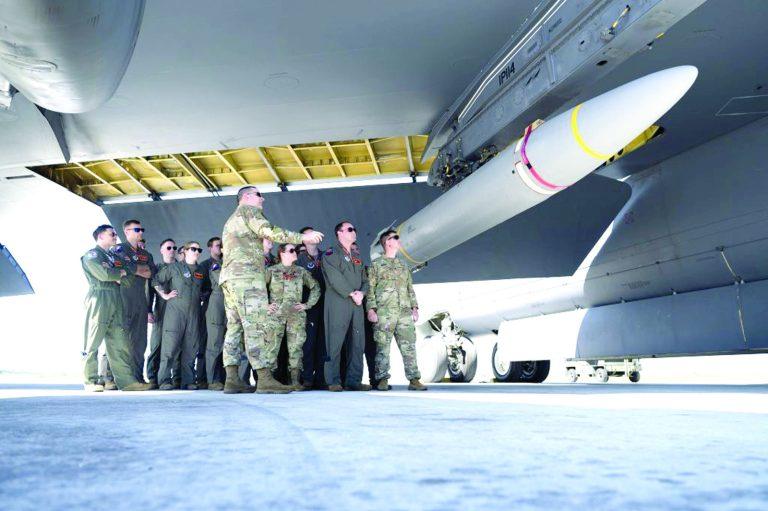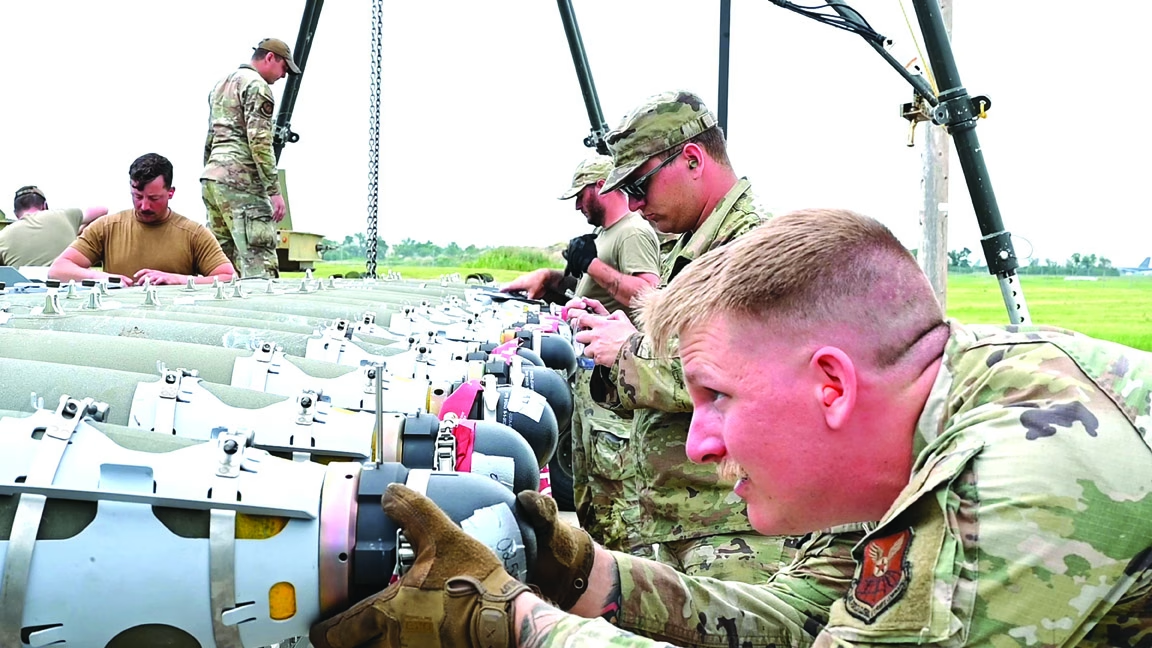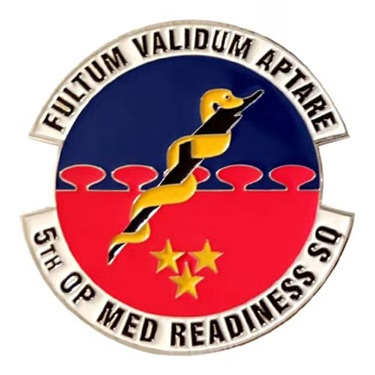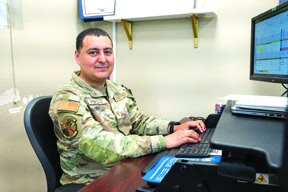The Air Force has published images of an operational hypersonic Air-Launched Rapid-Response Weapon (ARRW) in Guam; a disclosure possibly meant to send a message to China but which raises questions about the future of the ARRW, which the Air Force insists it is not planning to procure in quantity.
The images, released by the 36th Wing, showed air and ground crews at Andersen Air Force Base, Guam, receiving “hypersonic weapon familiarization” with the AGM-183A ARRW on Feb. 27. The missile, which was mounted under the wing of a B-52H bomber, had yellow stripes, indicating it has a live warhead. Blue stripes indicate an inert weapon without a warhead, typically used for captive-carry tests or loading training.
The Air Force’s unveiling of the ARRW in a forward location may be a message to China that the U.S. can now field a hypersonic capability in the Pacific. It may also be the simple familiarization described, but it would be unusual to take a highly limited test asset to a forward base without another purpose in mind. The Air Force did not disclose whether the missile would remain at the base.
Andersen is a key base in the Pacific, and Air Force bombers routinely deploy there for weeks at a time, engaging in training, wargames, and show-the-flag messaging operations. These include “freedom of navigation” flights through China’s air defense identification zone. Such Bomber Task Forces (BTFs) have increased in the last few years, while at the same time China has stepped up the frequency of exercises in which it bluff-charges Taiwan’s ADIZ with as many as 80 aircraft, a pattern seemingly meant to test Taiwan’s air defenses but also potentially intended to reduce Taiwan’s alertness with chronic false alarms of an invasion.
It’s not clear from the photos released whether more than one missile was included in the training. All the photos showed a single missile mounted on a pylon under the aircraft’s starboard wing. The Air Force has said a B-52 can carry up to four ARRWs on wing pylons.
About two dozen Air Force personnel were shown receiving the instruction.
The missile in the photos carries the serial number AR-AUR-005. The “AUR” likely references the term “All-Up Round,” the nomenclature for ARRWs that have a live ATACMS booster and live warhead. The Air Force released images of a similar training event at Edwards Air Force Base, Calif., last year, and the missile in those photos had the serial AR-AUR-004.
If the Air Force plans to test-launch the missile in the photos in the Western Pacific, it would be the first time such a launch has occurred away from the coast of California, where all ARRW tests have been conducted so far.
The release said B-52 crews of the 23rd Expeditionary Bomb Squadron out of Minot Air Force Base, N.D., and the 49th Test and Evaluation Squadron out of Barksdale Air Force Base, La., conducted the familiarization. Personnel received “expert academics and training on hypersonic fundamentals and participated in tactical discussion on hypersonic operations to increase operational readiness,” the release stated. The instruction also included a discussion about logistics for hypersonic weapons.
The program is meant to “prepare multiple Air Force aircraft communities for hypersonics, including the Hypersonic Attack Cruise Missile,” ARRW, and “other programs under development,” according to the release. It did not provide further details.
Lockheed Martin Missiles and Fire Control is the prime contractor for ARRW—a boost-glide type of hypersonic weapon—while Raytheon is developing the HACM, which is a smaller, longer-ranged, air-breathing weapon, the engine for which is being developed by Northrop Grumman.
The ARRW has a checkered track record in Air Force tests, with at least two outright launch failures as well as test glitches during the captive-carry phase of evaluation. The first test reported as a full success of the all-up round was flown on Dec. 9, 2022; two others were flown in August and October last year, apparently successful. The Pentagon’s Director of Operational Test and Evaluation, in his recent report about 2023 activities, said the all-up ARRW flown last August had some problems with telemetry in the endgame but otherwise flew a nominal mission and achieved successful warhead detonation.
Air Force officials said there is one formal ARRW test yet to go.
Just a year ago, Air Force acquisition executive Andrew Hunter told the House Armed Services Committee in written prepared testimony that the Air Force “does not intend to pursue follow-on procurement” of ARRW. However, he said there is “inherent benefit to completing All-Up Round test flights … to garner the learning and test data that will help inform future hypersonic programs and potential leave-behind capability.”
Air Force budget documents said closeout testing of the ARRW would take place in fiscal year 2024, during which the flight envelope for launch will be further expanded, flying qualities will be assessed, and the weapon will be tested against ground targets.
Much about the ARRW contract is classified, but the Air Force has acknowledged that Lockheed Martin was to conduct design and development, produce a certain number of missiles for test, and produce an undisclosed number of “leave behind,” or left-over assets after testing that could be used operationally. Lockheed was also to demonstrate that it could produce the ARRW at scale, something the company has said it accomplished.
Subsequent to Hunter’s comment, Air Force Secretary Frank Kendall said the Air Force has shifted its focus to the HACM, which will be a smaller, longer-ranged weapon that could be carried by fighter-sized aircraft. The ARRW can only be carried by bombers.
It’s not clear if the Air Force is changing its procurement position on ARRW. William LaPlante, undersecretary of defense for acquisition and sustainment, deferred questions on hypersonics and ARRW in particular during a House Armed Services Committee hearing in mid-February, asking for a closed session to discuss the subject in a secure facility.
Asked why ARRW isn’t being procured, despite being the only successfully-tested U.S. hypersonic weapon so far, LaPante said, “Let’s just say there is a plan. It’s not something we can talk about in this open session.”
Air Force officials said ARRW plans will become more clear in the budget request that will be forwarded to Congress on March 11.
Last March, the Congressional Budget Office pegged the unit cost of an air-launched hypersonic missile “similar to” the ARRW at between $15 million and $18 million across a production run of 300 missiles, but a ground-launched version would cost three times as much, due to the special launch infrastructure and additional boost capacity required. The CBO said it used the term “similar” because the actual numbers are classified.
Kendall has said that while hypersonic missiles match well to China’s operational concepts, they are less critical to USAF’s concepts of fighting and are important but not a top priority for investment.
A hypersonic ground-attack missile is best suited for striking high-value targets like command-and-control centers from long range, at high speed. Such weapons derive their destructive force both from a warhead and from the kinetic force of striking the ground at five times the speed of sound. Defense against hypersonic missiles, particularly if they are maneuvering, is difficult.
China is known to have deployed an undisclosed number of hypersonic DF-17 missiles with a long-range, tactical capability, while it has also developed hypersonic weapons to be mounted on intercontinental ballistic missiles. The DF-17 has been called a “carrier killer” and is also suited to a strike on a base like Guam.
“The Department of Defense is developing hypersonic science and technology to ensure the U.S. can rapidly field operational hypersonic systems,” the USAF said in its release about the familiarization program in Guam. The Air Force specifically “will continue to invest in researching, developing, testing, producing and fielding cost-effective weapons,” it continued. “These weapons are a mix of stand-off, stand-in hypersonic and subsonic precision-guided munitions. The Air Force also continues to develop revolutionary advanced weapon capabilities to maintain a competitive advantage over the pacing threat.”












